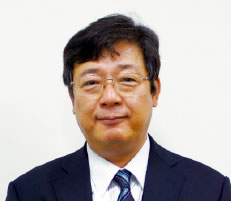- Notice
Special experiments in science and mathematics to convey the "excitement of seeing for yourself
2013.10.29
Moriaki Yamauchi, Teacher, Konan High School and Junior High School
Konan High School, where teachers with various areas of expertise gather, holds an annual "special experiment" program for second-year students in the science and mathematics courses. Students choose one of nine programs in which the teacher's specialty is utilized, and participate in the program. Each of the nine programs is basically a week-long immersion in experiments. We interviewed Mr. Moriaki Yamauchi, the teacher in charge of the seaside training program.

Two legs, teacher and researcher
While working as a faculty member, Dr. Yamauchi was also involved in oceanographic research projects as a JAMSTEC (Japan Agency for Marine-Earth Science and Technology) current researcher from 1997 to 2001. His specialty was geology, and he studied global climate change with paleontological targets. His target was fossil plankton called radiolaria, a type of paleontology with a size of 200 to 400 micrometers. During long school vacations, he would board the Ocean Earth Research Vessel "Mirai" to collect samples, return to the school to remove radiolarian fossils from the strata, and then make a preliminary set of samples for assemblage analysis. It is known that the ratio of species of radiolarians varies with seawater temperature, and by examining the radiolarians in the strata, paleo-water temperatures can be identified. The variations in paleowater temperatures identified by the professor's examination of samples from six sites correlate well with global climate change. He is the first person in the world to use radiolarian communities to identify fluctuations in sea water temperature and water mass.
Summer Seaside Training
Every year during summer vacation, Mr. Yamauchi takes his students to Kumihama, located on the Sea of Japan coast of Hyogo Prefecture, for a seaside training trip. On the first day, he and his students head out to the sea to procure sea urchins to use as experimental materials. They brought the sea urchins back to the beach, cooling them to prevent them from releasing their eggs on the way, and then released and fertilized them on the same day. The next day, they observed the development of the fertilized sea urchins. With the cooperation of a professor from Konan University, they also conduct an experiment using a developmental inhibitor.
In parallel with this experiment, we will also conduct a survey of seawater quality. They will ride a cruiser to collect mud, water, and plankton, as well as measure water temperature, salinity, pH, and chlorophyll concentration using a multi-purpose water quality meter. The students will be able to see with their own eyes and touch the seawater and experience for themselves that the water temperature at the sea surface is 28°C, but at a depth of 10 meters, the water temperature is considerably colder at 10°C.
The joy of discovery comes from real-life experience.
The teacher insists on exposure to the real thing. The development of sea urchins can be easily observed using a prepackaged teaching material, and the relationship between water depth and temperature can be found in the literature. However, one cannot experience the movement of fertilized eggs in front of one's eyes, the sense of time of development, or the smell of hydrogen sulfide and methane coming from the mud on the sea bottom that is taken down from the rope, only in the laboratory. On the other hand, today's high school students can easily view beautiful images on the Internet, so they are less moved by real-life experiences. He said, "Children who can be surprised by the experiences in front of them have the joy of discovery. Our goal is to increase the number of such students through various experiences," says the teacher.
Article in the December 2012 issue of Kyoiku Ouen, a science education information magazine
Affiliations are current at the time of publication in Education Support.
